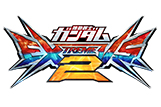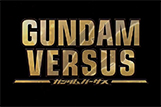Features: Zone of the Pretenders
Posted on : 08-09-2009 | By : Cacophanus | In : Features
Hardware: GameBoy Advance, PlayStation 2
0
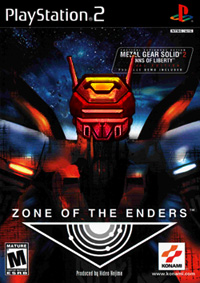 In December of 1999, SEGA released a nigh-on arcade perfect port on their ill-fated Dreamcast for Virtual On Oratorio Tangram. Like the Saturn port of its precursor, it also featured a bespoke controller to emulate the arcade version’s original setup: a pair of twinsticks. It was critically lauded by almost all Japanese (and many Western) publications and did quite well in terms of sales too.
In December of 1999, SEGA released a nigh-on arcade perfect port on their ill-fated Dreamcast for Virtual On Oratorio Tangram. Like the Saturn port of its precursor, it also featured a bespoke controller to emulate the arcade version’s original setup: a pair of twinsticks. It was critically lauded by almost all Japanese (and many Western) publications and did quite well in terms of sales too.
The thing with the Virtual On series though is that they’ve always been focused around human multiplayer. In that regard they are practically peerless. As to their singleplayer “experience”; it’s almost been an oversight.
Even Hajime Katoki’s mecha design was forcibly restrained for the various Virtuaroids, as the 1995 original had very stringent polygon counts which set the aesthetic. The first two Virtual On games in fact are almost exercises in functional minimalism.
Yet Virtual On, as a series, has had a remarkable amount of design-based progeny over the years but in the case of Oratorio Tangram such “offspring” would only be a few years away.
Cue Hideo Kojima…
Zone of the Enders (2001)
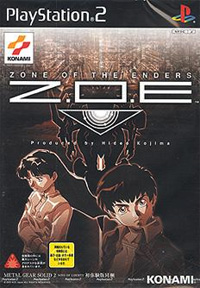 Zone of the Enders, or just plain ZOE, was a game set in the far off future in an O’Neill-esque colony in orbit around Jupiter. A force of mecha, known as orbital frames, infiltrate the colony in the hope of capturing a new experimental prototype orbital frame called Jehuty. As if the parallels with the original Gundam narrative aren’t striking enough: the game’s protagonist, a young boy by the name of Leo Steinbeck, stumbles upon Jehuty and is conveniently blown into its cockpit resulting in much mechanical ass kicking of the enemy forces.
Zone of the Enders, or just plain ZOE, was a game set in the far off future in an O’Neill-esque colony in orbit around Jupiter. A force of mecha, known as orbital frames, infiltrate the colony in the hope of capturing a new experimental prototype orbital frame called Jehuty. As if the parallels with the original Gundam narrative aren’t striking enough: the game’s protagonist, a young boy by the name of Leo Steinbeck, stumbles upon Jehuty and is conveniently blown into its cockpit resulting in much mechanical ass kicking of the enemy forces.
Functionally, the control of Jehuty was uncannily akin to piloting a Virtuaroid. In that, Jehuty had two main modes of combat; dash based long ranged attacks and circular strafing melee attacks. However, unlike a Virtuaroid, Jehuty had no means to cross the distance between ranged and melee combat effectively.
In Virtual On combat was linked by fixed length dashes, which interconnected until the player reached a close enough range to swipe them with a melee attack. ZOE had an analogue dash function, which meant there was no functional linkage between ranged and melee combat. This was compounded in the original ZOE due to the slow speed at which Jehuty moved and initiated its attacks.
The only real functional progression ZOE had over Virtual On was the means in which Jehuty could circle strafe its melee attacks in a spherical fashion. Admittedly the bulk of ZOE’s combat was similarly planar to Virtual On but the melee attacks could operate properly in three dimensions: as you circled underneath or above an enemy orbital frame to slice them from behind. Unfortunately the speed at which Jehuty moved made this rather mundane. Doubly so when the enemy units could manoeuvre at a greater speed in some instances, ultimately rendering the melee combat almost random in terms of its effectiveness.
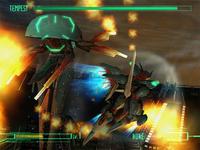 Irritatingly, the initial narrative in the first ZOE game was actually quite sketchy and the game ended in a manner almost cursory. I say irritating, as the over arching conflict and back-story are genuinely fascinating and, in my opinion, rather well wrought. Thankfully, the second game does help to cover the meat of the narrative in a more thorough fashion, though more of this later.
Irritatingly, the initial narrative in the first ZOE game was actually quite sketchy and the game ended in a manner almost cursory. I say irritating, as the over arching conflict and back-story are genuinely fascinating and, in my opinion, rather well wrought. Thankfully, the second game does help to cover the meat of the narrative in a more thorough fashion, though more of this later.
The focus of ZOE though was predominantly that of the singleplayer progression, so direct comparisons with Virtual On are only really valid in terms of the game’s core mechanics and not the over arching narrative (as Virtual On technically doesn’t have a gaming narrative, though there is an awful lot of print based literature for Virtual On but it wouldn’t be fair to include that here). ZOE was trying, albeit in a very clumsy way, to re-create an anime narrative that gamers could partake in and that is laudable.
In addition, Yoji Shinkawa’s mechanical design was and remains incredibly progressive. Arguably, Shinkawa’s artistic proficiency helped give a much-needed lift to the mediocre and dated gaming functionality.
ZOE was also memorably bundled with a Metal Gear Solid 2 demo, to the point that almost everyone bought the game for the demo rather than the mecha game with its name on the box. It was a shrewd move, as the sales would have been a useful bargaining tactic to make more games and allow Kojima et al to creatively “branch out” into other genres.
Anubis (2003)
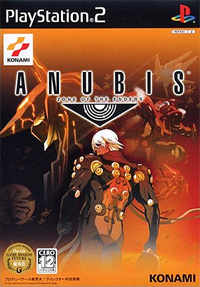 Two years after the first ZOE, Anubis was released. This was quite a substantial improvement over the original game; both in terms of combat speed and functional variety, but it still suffered from the same issue between the two modes of combat.
Two years after the first ZOE, Anubis was released. This was quite a substantial improvement over the original game; both in terms of combat speed and functional variety, but it still suffered from the same issue between the two modes of combat.
Jehuty also had a greater array of weapons at its disposal now and a far more effective grab move, as you could utilise elements of the environment and even enemy units as impromptu melee weapons. Yet, the two elements of combat were still very much separated from one another. Even later in the game when Jehuty is upgraded to the point it can use a function called “Zero Shift”, that crossed the gap between the two elements of combat by teleporting the player to melee range almost instantaneously, felt very clumsy as it required no tactics to use effectively.
Anubis also suffered several silent revisions in Japan improving boss balancing and enemy squad AI until that culminated in a final “Special Edition”, which more elegantly solved the issue between ranged and melee combat by having more intelligent squad based AI. This forced the player to approach groups of enemy orbital frames with greater care and an intensified sense of spatial awareness. Even then this improvement only accentuated the brilliance of Oratorio Tangram, which a few years prior had managed to incorporated all these elements in a seamless whole.
Anubis also finally covered the bleak narrative in far more detail. Gone where the shonky CG rendered cutscenes and instead replacing those with traditional cel-shaded animation, which fitted the whole mecha anime influence more convincingly.
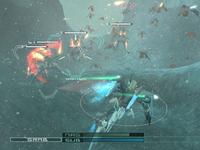 In all fairness, Anubis’ narrative was impressively executed. Not only was it very well written but it produced a functional context where Jehuty and the main protagonist, now by the name of Dingo Egret, really were the nexus that could turn the tide against the terrifyingly potent Bahram forces. Throughout the game there is an oppressive sense of foreboding that frames the action in a way that gaming doesn’t normally experience very often.
In all fairness, Anubis’ narrative was impressively executed. Not only was it very well written but it produced a functional context where Jehuty and the main protagonist, now by the name of Dingo Egret, really were the nexus that could turn the tide against the terrifyingly potent Bahram forces. Throughout the game there is an oppressive sense of foreboding that frames the action in a way that gaming doesn’t normally experience very often.
The only other mecha gaming series that comes close to this level of narrative is Armored Core but that has never been given an adequate localisation, mainly due to its subtlety most probably. Anubis is far more straight-laced in terms of its plot in comparison, so the subsequent localisation was more manageable.
 Again, Shinkawa’s design work was breathtakingly executed. With a whole new graphical engine, using subtle elements of cel shading on some of the explosion effects and just a fantastic use of lighting, the mecha design was simply radiant. Even the brilliant usage of the Vic Viper fighter from Gradius as the basis for a transformable mecha was a stroke of genius. Thankfully, there is an excellent artbook available (as seen to your right) which shows the work that went into these designs and whilst Kojima bizarrely seems to take credit for the games (despite simply copying the core mechanics from Virtual On), it’s Shinkawa that should be given a greater level of creative credence. As he’s managed to encapsulate the real robot design mantra in a way that’s beautifully ethereal. Something almost no-one, bar Mamoru Nagano, has managed to successfully pull off.
Again, Shinkawa’s design work was breathtakingly executed. With a whole new graphical engine, using subtle elements of cel shading on some of the explosion effects and just a fantastic use of lighting, the mecha design was simply radiant. Even the brilliant usage of the Vic Viper fighter from Gradius as the basis for a transformable mecha was a stroke of genius. Thankfully, there is an excellent artbook available (as seen to your right) which shows the work that went into these designs and whilst Kojima bizarrely seems to take credit for the games (despite simply copying the core mechanics from Virtual On), it’s Shinkawa that should be given a greater level of creative credence. As he’s managed to encapsulate the real robot design mantra in a way that’s beautifully ethereal. Something almost no-one, bar Mamoru Nagano, has managed to successfully pull off.
Due to the lack of Metal Gear Solid demo bundled with Anubis, its sales were more inline with the game’s target demographic. Even in Japan it was very much a cult hit, doubly so abroad. This was unfortunate as Anubis was definitely a superior game when compared to ZOE but its actual popularity cast a more realistic shadow over the series’ future.
Zone of the Ending?
Despite the excellent Fist of Mars, which is a capable Super Robot Wars clone, the PlayStation 2 ZOE games leave a fair amount to be functionally desired.
Due to the barren landscape of mecha gaming outside of Japan, a large number of people fallaciously assume that games like ZOE and Anubis are without peers. That these games are even a pinnacle for the mecha gaming genre. Unfortunately, they aren’t. Functionally, ZOE still has issues that probably can’t be resolved (even the ACE games suffer from a similar, though less obvious, flaw). Kojima has sidestepped these problems by making greater emphasis on the narrative, to the point that an anime series has spawned from the games.
This is not to say that this isn’t a worthwhile endeavour, as gaming narrative is something that requires further development and it even fits well with the influences from mecha anime in this instance. Yet, you’re still controlling a mechanical avatar throughout the narrative and this is what ultimately constitutes the bulk of the game.
As such, it might be worth considering that the functionality should receive as much attention as the plot. At the very least hire Juro Watari and the remainder of the Virtual On team to do it properly.

